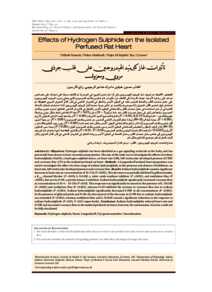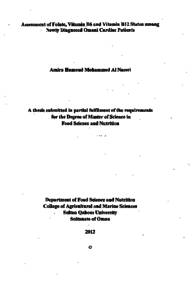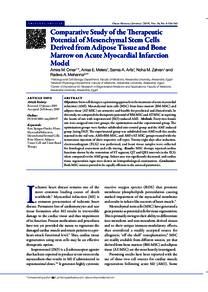Document
Effects of hydrogen sulphide on the isolated perfused rat heart.
Contributors
Other titles
تأثيرات غاز كبريتيد الهيدروجين على قلب جرذي مروي ومعزول.
Publisher
College of Medicine, Sultan Qaboos University.
Gregorian
2011-05
Language
English
English abstract
Objectives: Hydrogen sulphide has been identified as a gas signalling molecule in the body, and has previously been shown to have vasorelaxant properties. The aim of the study was to investigate the effects of sodium hydrosulphide (NaHS), a hydrogen sulphide donor, on heart rate (HR), left ventricular developed pressure (LVDP) and coronary flow (CF) in the isolated perfused rat heart. Methods: A Langendorff isolated heart preparation was used to investigate the effect of a dose range of sodium hydrosulphide, in the presence and absence of inhibitors, on heart rate, left ventricular developed pressure and coronary flow. Results: Sodium hydrosulphide caused a significant decrease in heart rate at a concentration of 10-3 M (P <0.001). This decrease was partially inhibited by glibenclamide, a KATP channel blocker (P <0.05); L-NAME, a nitric oxide synthase inhibitor (P <0.001), and methylene blue (P <0.001), but not by H-89, a protein kinase A inhibitor. Sodium hydrosulphide significantly increased coronary flow at concentrations of 10-4 – 10-3M (P <0.05). This response was significantly increased in the presence of L-NAME (P <0.001) and methylene blue (P <0.001), whereas H-89 inhibited the increase in coronary flow due to sodium hydrosulphide (P <0.001). Sodium hydrosulphide significantly decreased LVDP at all concentrations (P <0.001). In the presence of glibenclamide and H-89, the time period of the decrease in LVDP due to sodium hydrosulphide was extended (P <0.001), whereas methylene blue and L-NAME caused a significant reduction in the response to sodium hydrosulphide (P <0.05, P <0.01 respectively). Conclusion: Sodium hydrosulphide reduced heart rate and LVDP, and increased coronary flow in the isolated perfused rat heart; however, the mechanisms of action could not be fully elucidated.
Member of
Resource URL
Citation
Hussain, Afthab، Maddock, Helen، Al-Rajaibiyah, Hajar، &Carson, Ray J (2011). Effects of Hydrogen Sulphide on the Isolated Perfused Rat Heart. SQU MED J, 11 (2), 236-243.
Arabic abstract
الأهداف: تم تعريف غاز كبريتيد الهيدروجين على أنه غاز متميز الجزيء في الجسم، إذ تم الكشف مسبقا على احتوائه على خصائص تساعد على رخاوة الأوعية. تهدف الدراسة إلى الكشف عن تأثيرات غاز هایدروسلفايد الصوديوم (الذي يعطي بدوره كبريتيد الهيدروجين) على معدل نبضات القلب والضغط المترتب عليه في البطين الأيسر والتدفق في الشريان التاجي في قلب الفأر المعزول المروي. الطريقة: تم استخدام طرق تحضير القلب المعزول (لاند جيندروف) للبحث عن تأثير جرعة محددة لغاز کبريتيد الهيدروجين أثناء استخدام مثبطات النشاط الكيميائي أو عدم استخدامه في معدل نبضات القلب والضغط في البطين الأيسر والتدفق في الشريان التاجي. النتائج: تسببت هيدروسولفايد الصوديوم بانخفاض كبير في معدل ضربات القلب عند شدة تركيز (3 - 10) مول (
0.05
>P) هذا الانخفاض تثبط بشكل جزئي بواسطة جليبينكلامايد – المانع لقناة
P<0.05) KATP )، المثبط لتصنيع أكسيد النتريك (
0.001
>P)، والمثبط أيضا لإنتاج المثيلين الأزرق ( 0.001 >P). بينما ثبط ال (H-89) زيادة تدفق الشريان التاجي المتسبب عن هايدروسلفايد الصوديوم (
0.001
>P). من جهة أخرى، قلل هایدروسلفايد الصوديوم (أيا كان تركيزه) الضغط في البطين الأيسر بشكل معتد إحصائيا (
0.001
>P). وفي وجود الجليبينكلاماید و (H-89) كان الوقت المطلوب لتخفيض الضغط في البطين الأيسر بسبب هایدروسلفايد الصوديوم أطول (
0.001
>P) بينما سبب المثيلين الأزرق و( L-NAME ) نقصا للاستجابة لهايدروسلفايد الصوديوم (
0.05
> P<0.01 ،P
) بالتتابع. الخلاصة: أدى استخدام غاز كبريتيد الهيدروجين إلى خفض معدل نبضات القلب ومعدل الضغط في البطين الأيسر وزيادة التدفق في الشريان التاجي في قلب الفأر المعزول ولكن آليات العمل لم تقم بتوضيح النتائج بشكل تام.
0.05
>P) هذا الانخفاض تثبط بشكل جزئي بواسطة جليبينكلامايد – المانع لقناة
P<0.05) KATP )، المثبط لتصنيع أكسيد النتريك (
0.001
>P)، والمثبط أيضا لإنتاج المثيلين الأزرق ( 0.001 >P). بينما ثبط ال (H-89) زيادة تدفق الشريان التاجي المتسبب عن هايدروسلفايد الصوديوم (
0.001
>P). من جهة أخرى، قلل هایدروسلفايد الصوديوم (أيا كان تركيزه) الضغط في البطين الأيسر بشكل معتد إحصائيا (
0.001
>P). وفي وجود الجليبينكلاماید و (H-89) كان الوقت المطلوب لتخفيض الضغط في البطين الأيسر بسبب هایدروسلفايد الصوديوم أطول (
0.001
>P) بينما سبب المثيلين الأزرق و( L-NAME ) نقصا للاستجابة لهايدروسلفايد الصوديوم (
0.05
> P<0.01 ،P
) بالتتابع. الخلاصة: أدى استخدام غاز كبريتيد الهيدروجين إلى خفض معدل نبضات القلب ومعدل الضغط في البطين الأيسر وزيادة التدفق في الشريان التاجي في قلب الفأر المعزول ولكن آليات العمل لم تقم بتوضيح النتائج بشكل تام.
Category
Journal articles



